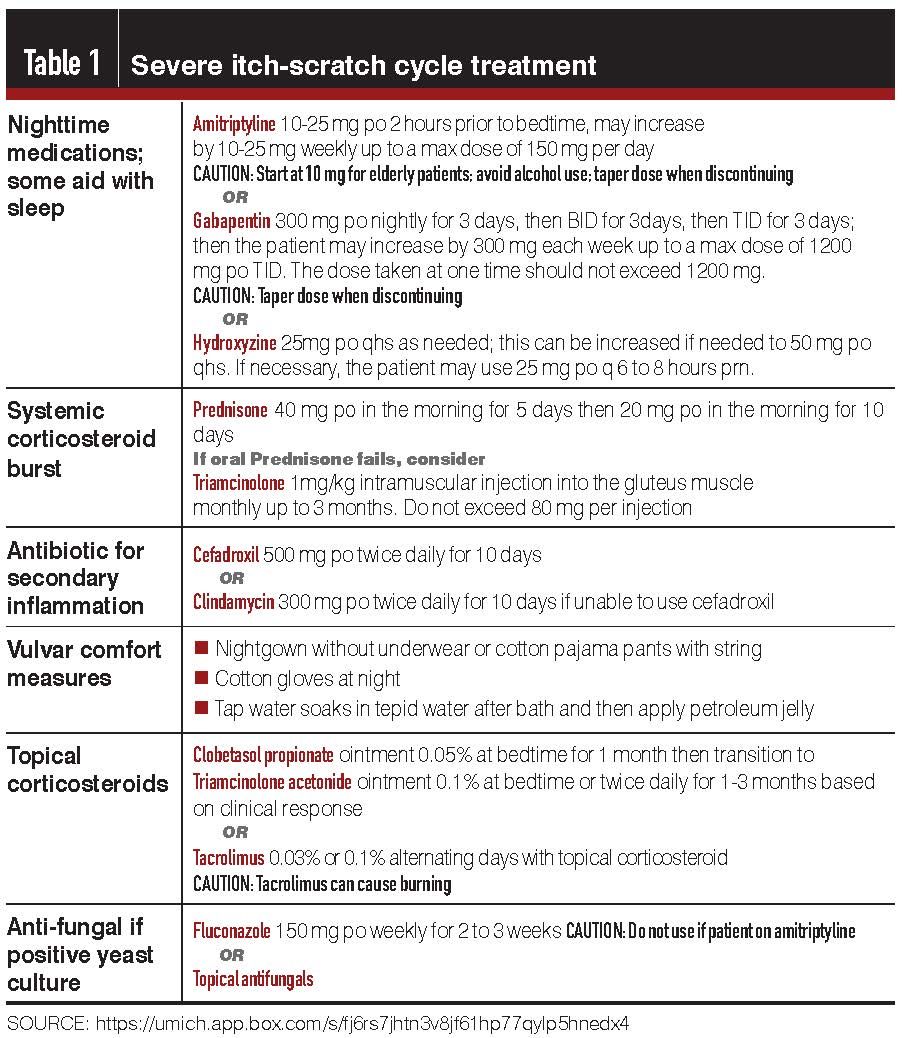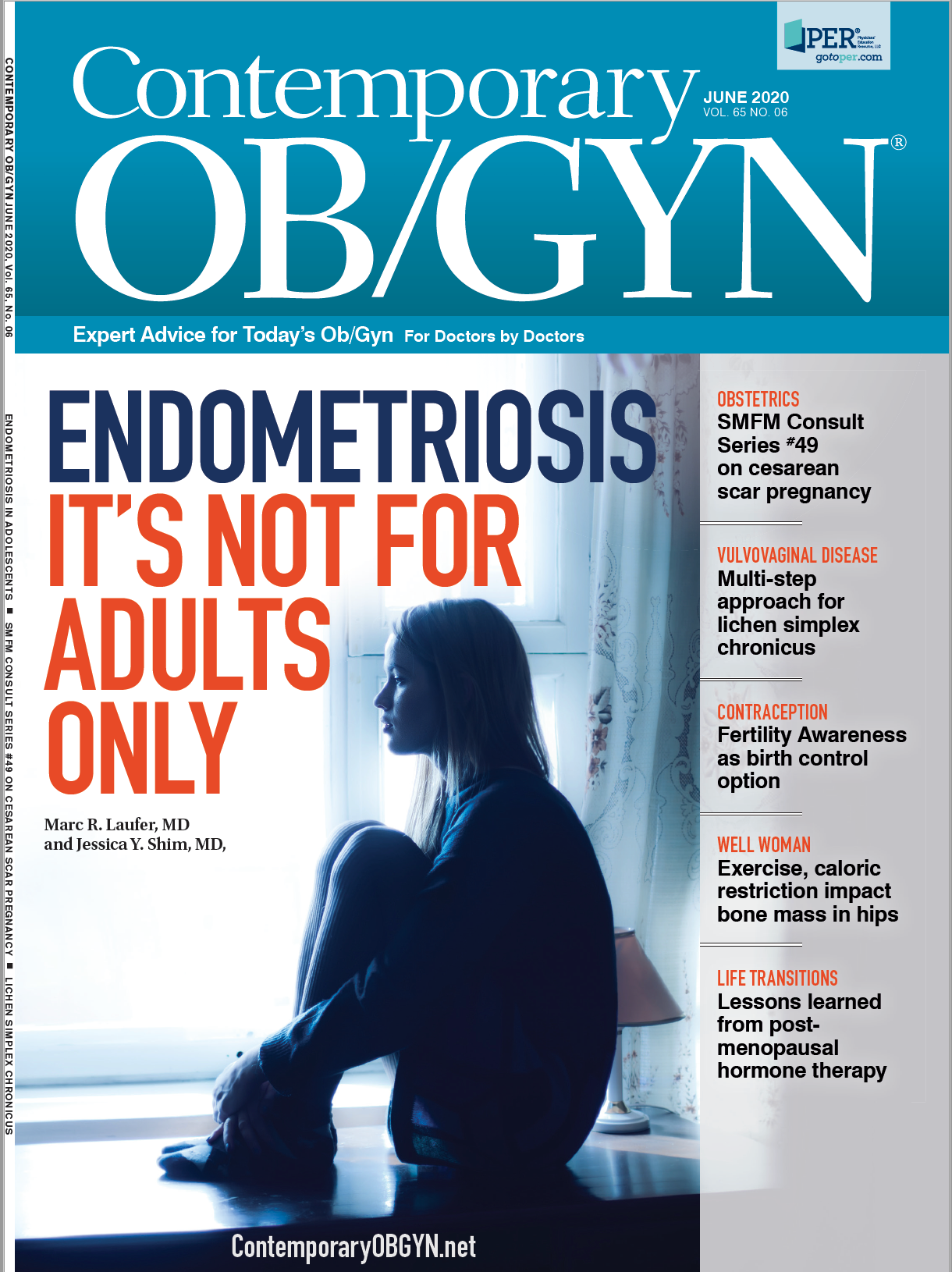Multistep approach for lichen simplex chronicus
Would you be able to recognize this diagnosis in your practice?

Presentation
45-year-old female presents to her primary care physician complaining of changes in her vulvar skin with intermittent irritation and some bleeding. She had recently experienced severe pruritus and white discharge which she treated with an over-the-counter anti-fungal cream for vulvovaginal candidiasis. However, her symptoms were only partially alleviated. On examination, she was noted to have thickening and wrinkling of the skin of the labia majora. Excoriations were seen (Figure 1).
Discussion
The history and physical examination are consistent with the diagnosis of lichen simplex chronicus. Lichen simplex chronicus is a non-specific skin condition that results from repetitive scratching or rubbing of the skin in response to pruritus.1 Other terms that have been utilized for this condition include hyperplastic dystrophy, squamous cell hyperplasia, and pruritus vulvae.2,3 Lichen simplex chronicus is estimated to occur in the anogenital region in 5% of all Western European and American adults.3
Patients with lichen simplex chronicus typically complain of intense pruritus which can be chronic or intermittent and exacerbated by heat, stress, or menstruation.3 On examination you will observe lichenification or hard thickened skin. You may also note wrinkling of the skin, hair loss in areas of scratching, excoriations, erosions, hyperpigmentation or white patches of skin.1,2
The development of lichen simplex chronicus is often secondary to a trigger that causes pruritus. This would include infections such as candida which is likely the trigger in this case. Other instigating factors include chemical or allergic irritants, underlying skin dermatoses such as eczema, psoriasis, lichen sclerosus, or lichen planus, and pre-cancers or cancers of the vulva.1,3
It can also be provoked by metabolic conditions such as diabetes mellitus or iron deficiency anemia. These triggers then result in a cycle of itching and scratching that ultimately compromises the skin’s protective barrier and results in inflammation.3 The altered skin barrier also increases the risk for secondary infection.
Diagnosis
The diagnosis is typically made based on history and physical examination. It is critical to obtain information about when the pruritus began, when the patient is scratching and rubbing and with what. We have had patients report using items as extreme as a wire brush. Patients will often report that there is temporary relief from the pruritus with scratching or rubbing.4
In addition, patients may often complain of painful urination or defecation and sexual activity which is typically related to the excoriations that can occur as a result of repetitive scratching or rubbing.1 You should also collect information about potential inciting events as well as current vulvar hygiene practices such as the type of underwear, frequency of showers/baths, whether tight clothing is worn, and whether soaps or other feminine hygiene products are utilized on the vulvar skin as well as fragrance or dyes in detergents for clothing.
A wet mount or yeast culture should be performed to rule out candidiasis. You should also consider a biopsy if the patient does not improve with initial therapies, or the gross appearance is concerning.1 A tissue biopsy can help to rule out other causes of pruritus and skin changes such as lichen sclerosus, lichen planus, psoriasis, high grade squamous intraepithelial lesions, and cancers.1,3
On histology, a tissue biopsy from a patient with lichen simplex chronicus will display thickening of epidermis (acanthosis) and hyperkeratosis.2 You may also see increased mitotic activity without cellular atypia in the hyperplastic epithelium and a lymphocytic infiltrate within the dermis.2
Management (Table 1)
At the University of Michigan Center for Vulvar Diseases, we utilize a multi-step approach to treat this diagnosis. It begins with education on appropriate vulvar care which includes keeping the area dry, avoiding potential irritants such as soaps, detergents, and fabric softener with dyes or fragrance, wearing cotton underwear, and avoiding tight clothing. We also recommend against using products with benzocaine given the risk of developing contact dermatitis from this medication.5
In addition, we advise our patients to utilize vulvar comfort measures focused on reducing scratching or rubbing such as tap water soaks in tepid water followed by application of a barrier to protect the skin (e.g. petroleum jelly). Patients are encouraged to wear cotton gloves at night to prevent scratching and wear a nightgown without underwear or cotton pajama pants with a string.3
Our treatment protocol also includes using medications to help with nighttime pruritus such as amitriptyline or gabapentin or hydroxyzine. Of note, if the patient complains of more pruritus during the day as opposed to at night, citalopram can be utilized instead of the medications listed for nighttime use.
In addition, we also prescribe an antibiotic, such as cefadroxil, to decrease secondary inflammation. You may utilize clindamycin instead of a cefadroxil in the case of severe penicillin or cephalosporin allergy. Do not forget to utilize an antifungal medication, such as oral fluconazole, if candida is discovered as part of your work-up. However, caution should be exercised if you are utilizing amitriptyline for nighttime pruritus. In these cases, you should utilize a topical rather than oral antifungal to avoid drug-drug interactions.
Once the skin has had an opportunity to heal, typically over the course of 4-5 days, the patient may then start topical corticosteroids such as clobetasol propionate ointment followed by triamcinolone acetonide ointment. It is important to instruct the patient where to apply the topical corticosteroids.3 Only a thin film should be applied to avoid the side effects associated with overuse which include tissue thinning, striae and rebound dermatitis.3
If the patient fails topical corticosteroids, a systemic corticosteroid burst may be needed. This can be achieved with an oral prednisone taper. If still no improvement with prednisone, an intramuscular injection of triamcinolone acetonide can be given into the gluteus muscle.
In some cases, a patient may require a longer course of topical corticosteroids for maintenance. In addition, recurrence is common even with complete resolution.1 Although, this inflammatory dermatitis does not increase the risk of malignancy, it can have significant ramifications for a patient’s quality of life.1,6 Thus if a patient is not responding to the treatment regimen, consider referral to a vulvar specialist.
References:
1. Chibnall R. Vulvar Pruritus and Lichen Simplex Chronicus. Obstet Gynecol Clin North Am. 2017;44(3):379-388. doi:10.1016/j.ogc.2017.04.003
2. Ellenson LH, Pirog EC. The Female Genital Tract. In: Kumar V, Abbas AK, Aster JC, eds. Pathologic Basis of Disease. 9th ed. Philadelphia, PA: Elsevier Saunders; 2015:991-1042.
3. Thorstensen KA, Birenbaum DL. Recognition and management of vulvar dermatologic conditions: lichen sclerosus, lichen planus, and lichen simplex chronicus. J Midwifery Womens Health. 2012;57(3):260-275.
4. Edwards L, Lynch P. Genital pruritus and the eczematous diseases. In: Genital Dermatology Atlas. 2nd ed. Philadelphia, PA: Lippincott Williams and Wilkins; 2011.
5. Nguyen HL, Yiannias JA. Contact Dermatitis to Medications and Skin Products. Clin Rev Allergy Immunol. 2019;56(1):41-59. doi:10.1007/s12016-018-8705-0
6. Weiss M, Mettang T, Tschulena U, Weisshaar E. Health-related quality of life in haemodialysis patients suffering from chronic itch: results from GEHIS (German Epidemiology Haemodialysis Itch Study). Qual Life Res. 2016;25(12):3097-3106.

Current treatments for recurrent bacterial vaginosis leave many patients dissatisfied
February 28th 2025A new study presented at ISSWSH highlights patient dissatisfaction with current treatments for recurrent bacterial vaginosis, emphasizing the need for more effective therapies and improved provider communication.
Read More
Dequalinium chloride found noninferior to metronidazole for BV treatment
May 9th 2024Explore how dequalinium chloride stands as a promising alternative to metronidazole in treating bacterial vaginosis, offering comparable efficacy, safety, and tolerability, as revealed by a recent noninferiority trial.
Read More
